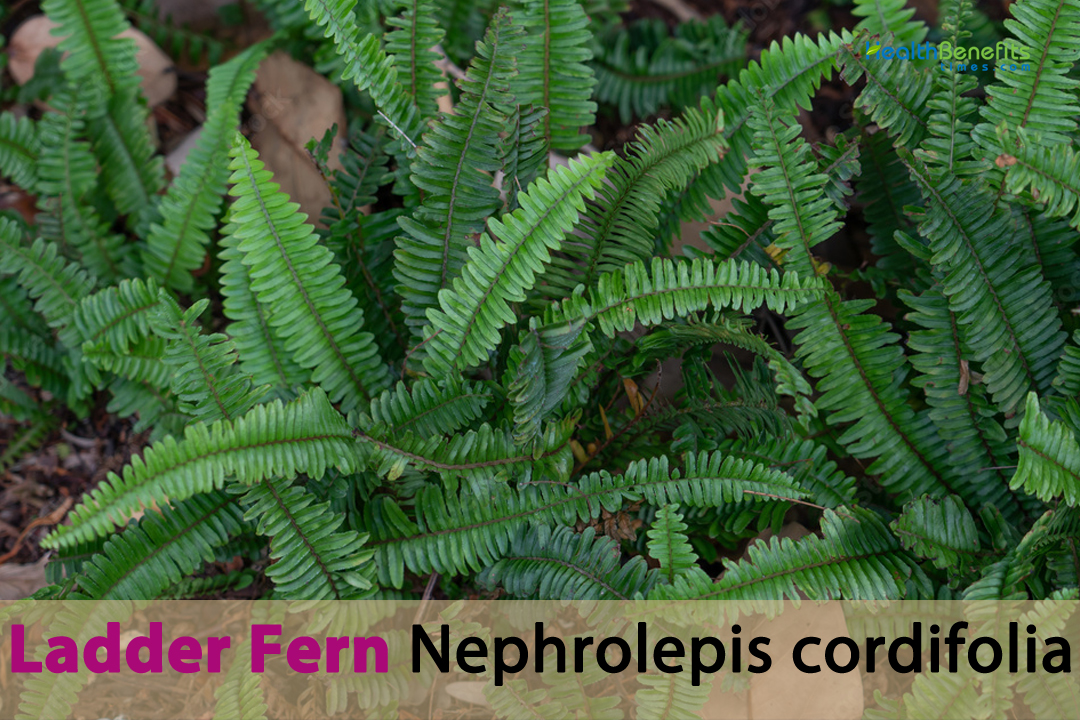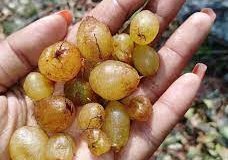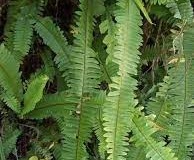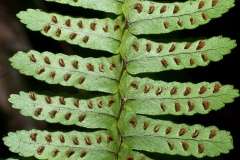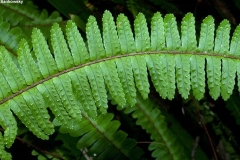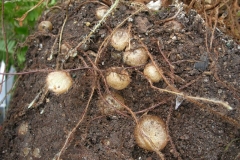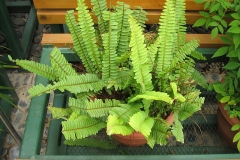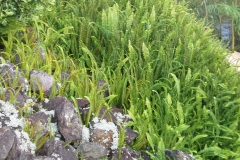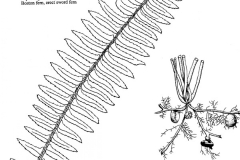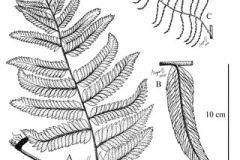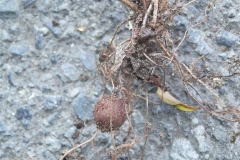| Ladder Fern Quick Facts | |
|---|---|
| Name: | Ladder Fern |
| Scientific Name: | Nephrolepis cordifolia |
| Origin | Nepal, Assam, Bangladesh, Borneo, Cambodia, China, Fiji, Hainan, Himalaya, India, Korea, Lesser Sunda Is., Malaya, Myanmar, Nansei-shoto, Queensland, Sri Lanka, Sulawesi, Taiwan, Thailand, Tibet, Vietnam |
| Colors | Brown or dark brown in color |
| Shapes | Typically small and capsule-like in shape, approximately 1 to 1.5 centimeters (0.4 to 0.6 inches) in length |
| Taste | Sour and sweet |
| Major nutrients | • Fiber • Vitamins • Minerals • Antioxidants • Phytochemicals • Water Contents |
| Health benefits | Respiratory Health, reduces Stress, Aesthetics and Mood Enhancement, Elevated Mood and Mental State, Enhanced Focus and Concentration, Enhanced Creativity |
| Name | Ladder Fern |
|---|---|
| Scientific Name | Nephrolepis cordifolia |
| Native | Nepal, Assam, Bangladesh, Borneo, Cambodia, China, Fiji, Hainan, Himalaya, India, Korea, Lesser Sunda Is., Malaya, Myanmar, Nansei-shoto, Queensland, Sri Lanka, Sulawesi, Taiwan, Thailand, Tibet, Vietnam, etc. It also has naturalized in tropical and subtropical regions of the Americas, including parts of Central and South America |
| Common Names | Fishbone fern, tuberous sword fern, tuber ladder fern, erect sword fern, narrow sword fern, ladder fern, and herringbone fern, southern sword fern, sword fern, tuber fern |
| Name in Other Languages | Albanian: Shpellë e Mia Arabic: Tarfat Alsayf (طرفة السيف), sifawi qalbi al’awraq (سيفاوي قلبي الأوراق) Armenian: Susaniq (Սուսանիկ) Azerbaijani: Mübariz Dərvişqulu Bengali: Tarun Karna (তরুণ কর্ণ) China: Bi zi cao, Shi huang pi, Wu gong cao, Jiàn Yè Fèng Wěi Jué (剑叶凤尾蕨), shèn jué (肾蕨) Croatian: Mačevnica Uspravna Czech: Mečík Vznešený Danish: Sværd-Bregne Dutch: Zwaardvaren English: Sword Fern, erect sword fern, ladder fern, tuberous sword fern, Narrow Sword Fern, Boston fern, Fishbone fern, Ladder fern, Tuber fern, Tuber ladder fern Estonian: Mõõgaparv Filipino: Espada Kawayan Finnish: Miekankämmen, Pystysulkasaniainen French: Fougère à Lames Georgian: Makhekhi (მახეხი) German: Schwertfarn Greek: Ftéli Spathioú (Φτέλη Σπαθιού) Hawaii: Kupukupu, Okupukupu, Ni’ani’au Hebrew: כליין לבוב Hindi: Talwar Fern (तलवार फर्न) Hungarian: Kardospáfrány India: Moothirakilangu Indonesia: Paku acel, Paku ubi, Pakis Pedang Italian: Felce Spada, felce pennata Japanese: Tama-shida, Keshōmon Kazura (ケショウモンカズラ), Tamashida (タマシダ) Lithuanian: Kalavijas Paparčio Latvian: Zobenglis Paparde Kannada: Katti Aneka (ಕತ್ತಿ ಅನೇಕ) Kazakh: Kiizdik Talu (Киіздік талу) Korean: Geom-eun Gosari (검은고사리), jul go sa ri (줄고사리) Macedonian: Mechevnitsa (Мечевница) Malay: Pakis Pedang Malayalam: Valli Maram (വള്ളി മരം) Malaysia: Pani amla Nepal: Pani amala (पानीअमला), Bhui amala, Ras Norwegian: Sverdsmykke Paiwan: ljavucuvucu Polish: Paproć Mieczowata Portuguese: Samambaia-Espada, samambaia-espada-estreita, samambaia-espada-tuberosa, samambaia-espinha-de-peixe, Escadinha do Céu Romanian: Feriga Cuţitel, Feriga Săbii Russian: Mechenosets velichavyy (Меченосец величавый), nefrolepis serdtselistnyy (нефролепис сердцелистный) Serbian: Mačevnica Uspravna (Мачевница Усправна) Slovak: Mečiar Vznešený Slovenian: Mečevnica Visoka Spanish: Helecho Espada, helecho serrucho Swedish: Svärdsbräken, Fjäderbräken Tamil: Valikkai Maram (வளிக்காய் மரம்) Telugu: Katti Chittu (కత్తి చిట్టు) Thai: Kui soi, Laan Saap Seua (ลานสาบเสือ), Fein bı mak̄hām (เฟินใบมะขาม) Turkish: Kılıç Yapraklı Eğreltiotu Ukrainian: Mechnis Vysokyy (Мечоніс Високий) Urdu: Talwar Ki Pati (تلوار کی پتی) Uzbek: Qilichqon Oʻsimlik Vietnamese: Ráy Kiếm |
| Plant Growth Habit | Terrestrial semi evergreen fern |
| Growing Climates | Wild in forests, creeks, fallen trees, wastelands, riverbanks, rock faces, parks, roadsides, gardens, deep swamps, ditches, railway lines, abandoned buildings, ruins, brooks, fence lines, suburban bush land, riparian areas, coastal environs and ditches of coniferous forest floodplains |
| Soil | Potted soil that drains well and holds water without getting too wet. You can use a mix made for houseplants or other indoor plants. |
| Plant Size | Between 40 and 80 centimeters, in extreme cases up to 1 meter |
| Root | Rhizomes are typically short, creeping, and covered with brown scales |
| Stipe | Stipe is relatively thin and may be greenish or light brown |
| Pinnae | Pinnae are the individual leaflets that make up the fronds. They are attached to the rachis (the main axis of the frond) and are usually arranged in pairs along its length |
| Sori | Sori are usually arranged in rows and are covered by indusia, which are protective structures. Spores produced in the sori are responsible for reproduction and dispersal of the fern |
| Leaflets | Leaflets are entire, sessile and elongate-lanceolate. They grow up to 4.8 centimeters long and up to 0.9 cm wide. They stand at a distance of less than 1 centimeter |
| Available Forms |
|
| Varieties |
|
| Plant Parts Used | Tubers, rhizomes, fronds |
| Propagation | By division, spores, runners or stolons and Offsets |
| Lifespan | Around 3 to 5 years or more with proper care |
| Health benefits |
|
Plant Description
Ladder Fern, also called Pani Amala, is a semi-evergreen fern that grows on land. It usually grows between 40 and 80 centimetres, but it can grow up to 1 meter in extreme cases. It has a root underground that has several small tubers. The plant grows wild in forests, creeks, wastelands, riverbanks, rock faces, roadsides, gardens, deep swamps, ditches, railway lines, abandoned buildings, ruins, brooks, parks, fence lines, suburban bush land, riparian areas, coastal areas, and ditches of coniferous forest floodplains. The plant likes soil mix that drains well and keeps water without getting too wet. You can use a mix made for houseplants or other indoor plants. People often keep it inside, especially in homes and businesses. It’s pretty and unique frond design makes rooms more interesting to look at. It can be put in hanging pots, on shelves, or in decorative containers to make the room look lush and warm.
Appropriate growing environments for Ladder Fern
Ladder Fern is a popular fern species that can thrive both indoors and outdoors under the right conditions. Here are the appropriate growing environments for Ladder Fern
- Light: Button Lemon Ferns like indirect light that is bright. Stay out of direct sunlight, because it can burn the leaves. Place them near a window that faces north or east so they can get indirect sunlight all day long.
- Temperature: The ideal room temperature for these plants is between 60 and 75°F (15 and 24°C). They don’t like temperatures that are too hot or too cold, so don’t put them near drafts or heating/cooling vents.
- Humidity: Lemon-button ferns do well in places with a lot of wetness. A 50% or higher humidity level is what you should aim for. You can mist the fern often, put a tray of water nearby, or use a mister to raise the humidity.
- Watering: Keep the earth moist, but don’t let it get too wet. When the top inch of the dirt feels dry to the touch, water the fern. Root rot can be avoided by making sure there is enough drainage.
- Soil: Use potted soil that drains well and holds water without getting too wet. You can use a mix made for houseplants or other indoor plants.
- Container: Plant Lemon Button Ferns in a container with drainage holes to prevent water accumulation at the roots.
- Fertilization: During the growth season (spring and summer), feed the fern a balanced, water-soluble fertilizer that has been diluted to half its strength every 4 to 6 weeks. During the winter, when plants are not growing, cut back on or stop feeding.
- Pruning: Remove any yellow or brown fronds to make the plant look neat and support new growth. Pruning also helps the plant get more air around it.
- Potting: Lemon Button Ferns may need to be repotted every couple of years to give them fresh soil and more room to grow. Choose a pot that is just a little bit bigger than the one you are using now.
- Pests and Diseases: Keep an eye out for aphids, mealy bugs, and spider mites, which are common plant pests. Check your plant often for signs of pests or diseases, and if you find any, take the right steps.
- Propagation: Lemon Button Ferns can be spread by dividing them. Carefully cut the plant into smaller pieces, making sure that each piece has healthy roots and leaves. Then, repot the smaller pieces.
Rhizomes
A ladder Fern grows from underground stems called rhizomes that creep. Rhizomes are long, horizontal roots that are the main way that plants grow new plants. New leaves grow from the rhizomes, and the old ones die off. This keeps the fern’s growth cycle going.
Fronds
The most noticeable part of a Ladder Fern is its leaves. They grow straight from the rhizomes and have many leaflets that are grouped like feathers. The leaves range in color from light green to dark green and have a unique look, which is why this fern is often used as a decoration.
Leaflets
Each frond is made up of many leaflets that are connected to the main axis of the frond, called the rachis. The leaflets are split in a way that makes them look like they have lobes, which is why it is called “Lobed Sword Fern.” The way the leaves are arranged makes the fronds look like fishbone, which adds to the fern’s beauty.
Pinnae
Pinnae are the names for the separate leaves. These pinnae are long, shaped like lances, and have sharp tips. They are connected to the rachis in a way that makes the fronds look like they are made of feathers.
Sori
Structures called sori (singular: sorus) can be found on the undersides of the leaves. Sporangia are structures that hold spores. Sori are groups of sporangia. These spores are the fern’s way of making new plants. A ladder Fern reproduces both sexually and vegetatively. It makes spores and spreads them around, and its rhizomes grow.
Indusia
A flap of tissue called an indusium often covers each sorus to protect it. The indusium helps protect the spores as they grow and is a trait that sets Ladder Fern and many other ferns apart.
History
Ladder Fern is thought to be native to tropical and subtropical areas, such as parts of Asia, Africa, and the Americas. However, its exact original range is not well known. Because the species can live in many different environments, it’s possible that it has a wide natural range. Ladder Fern has been grown as a decorative plant for a long time because it looks nice and is easy to grow. It is a popular choice for indoor and shady outdoor areas because its fronds are soft and feathery. The fern’s ability to grow well in places with not a lot of light has made it a favorite houseplant.
Varieties
Ladder Fern is not as diverse in terms of recognized botanical varieties as some other plant species. However, here are a few more varieties that have been known to exist:
- Nephrolepis cordifolia ‘Duffii’ (Duffii Fern): This type of Ladder Fern is known for growing in a tighter space and having smaller leaves than the normal Ladder Fern. The leaves often have many deep lobes, which makes them look complicated.
- Nephrolepis cordifolia ‘Lemon Buttons’: This cultivar is known for its small, round, button-like leaves. Most of the time, the fronds are shorter and more compact, which makes it a good choice for terrariums and other small areas.
- Nephrolepis cordifolia ‘Green Lady’: This type has blades that are very small and thin and look like feathers. The way the leaves curve makes for a beautiful effect.
- Nephrolepis cordifolia ‘Fluffy Ruffle’: As the name suggests, this variety has fronds that look like they have been ruffled. This gives them a more textured and full look than the normal form.
- Nephrolepis cordifolia ‘Crispy Wave’: This type is known for having frond edges that are wavy and undulating. The leaves are different from other Nephrolepis cordifolia fronds because they have a different feel.
- Nephrolepis cordifolia ‘Furcans’: This type has fronds that are deeply split into many small pieces, giving them a fine and detailed look. The fact that the pieces are often falcate (sickle-shaped) makes the whole thing looks more interesting.
- Nephrolepis cordifolia ‘Compacta’: People like this Ladder Fern because it grows in a more compact way than the normal Ladder Fern. Due to its smaller size, it is often chosen for growing indoors and in hanging baskets.
- Nephrolepis cordifolia ‘Fimbriata’: This variety is known for its leaflets with tiny fringes that make the fronds look unique and textured. The plant can look more delicate and intricate if it has fringed ends.
- Nephrolepis cordifolia ‘Mini Russells’: ‘Mini Russells’ is a dwarf form of Nephrolepis cordifolia ‘Curly Locks’ with shorter fronds and leaflets that are more closely spaced. Because it is small, it can fit in smaller areas and containers.
- Nephrolepis cordifolia ‘Variegata’: The fronds of this variety have streaks or areas of lighter or darker green, which is called variegation. Different shapes can add more visual interest to indoor and shaded outdoor spaces.
- Nephrolepis cordifolia ‘Bostoniensis Compacta’: This type of the Boston fern is a more compact version of Nephrolepis cordifolia, which is a close relative. Compared to the standard Boston fern, it has smaller, more compact leaves.
- Nephrolepis cordifolia ‘Curly Locks’: This cultivar is known for its wavy, curled leaves, which make it look unique and fun. The smoothness of the fronds makes them different from other fronds with lobes.
Health benefits of Ladder Fern
Ladder Fern is a type of fern that is often used as an ornamental plant indoors and in gardens. While it may not be widely known for its specific health benefits, like some other medicinal plants, having indoor plants like Ladder Fern can contribute to overall well-being in a few ways:
1. Respiratory Health
The ability of Sword Ferns to clean the air inside by getting rid of pollutants can be good for lung health. Cleaner air can make it less likely that your lungs will get irritated, which may be especially helpful for people with allergies, asthma, or other breathing problems.
2. Air Purification
People know that sword ferns can make the air in a room better. They can help clean the air of pollutants like formaldehyde, xylene, and toluene, which are often found indoors because of goods and materials used in homes. Better air quality can help people breathe better and feel better all around.
3. Humidity Regulation
Through a process called evaporation, sword ferns let water into the air. This naturally humidifying effect can help keep indoor humidity levels at the right level. This is especially helpful in dry indoor settings or during the colder months when heating systems can dry out the air. Having the right amount of humidity can help stop problems like dry skin and inflamed airways.
4. Sleep Quality
The appearance of Sword Ferns can make a room more comfortable by improving the air quality and controlling the humidity. This could improve the quality of sleep, since the right amount of humidity and clean air is both good for a good night’s rest.
5. Stress Reduction
Sword Ferns and other indoor plants have been linked to less stress, worry, and mental fatigue. The green plants and connection to nature can produce a calm and soothing environment that helps people relax and feel better about them.
6. Noise Reduction
Scientists have found that plants, like Sword Ferns, can absorb and block sound waves, which could make a room quieter. This can help you feel calmer and less stressed.
7. Biophilic Benefits
Biophilia is the natural desire that people have to connect with nature. This need is met by having Sword Ferns inside, which creates a sense of harmony with nature and makes the surroundings better.
8. Aesthetics and Mood Enhancement
Sword Ferns look nice because their leaves are lush and feathery. The way they look can improve the look of indoor areas, making them more attractive and inviting.
9. Cognitive Benefits
Some studies show that having house plants, like Sword Ferns, can help people focus, think more clearly, and get more done. Putting these plants in places where you work or study might make it easier to concentrate.
10. Reduced Allergens
Most people think that sword ferns are low-allergen plants, which makes them a good choice for people with allergies or sensitivity. Ferns don’t send out pollen like some flowering plants do. Instead, they send out seeds, which are less likely to cause allergies.
11. Anti-Inflammatory Potential
Compounds like flavonoids and tannins that are found in plants can help reduce inflammation. It’s possible that Ladder Fern has these chemicals, which could help reduce inflammation in the body as a whole. But this is just a guess and would need to be proven by science.
12. Elevated Mood and Mental State
Getting close to plants like Sword Ferns has been linked to better mental health and a better mood. Caring for plants, watching them grows, and meeting their needs can make you feel good and give you a sense of success.
13. Enhanced Focus and Concentration
Having house plants, like Sword Ferns, in places where you work or study may help you focus and concentrate. Their presence can help produce an environment that is pleasant to look at and helps you get work done.
14. Strengthening the Mind-Body Connection
Even though indoor plants can help make the mind-body link stronger, spending time in nature is better. Taking care of plants and watching how they grow naturally can help you be more present and feel more grounded.
15. Enhanced Creativity
Being around nature, even indoor plants like Sword Ferns, has been linked to better creative thought and problem-solving skills. Their ability to calm people down can help new thoughts come to mind.
16. Enhanced Biorhythm
Studies show that being around plants and being exposed to natural light cycles can help manage circadian rhythms and improve sleep. Putting Sword Ferns near windows lets them get natural light, which could have a good effect on your body’s internal clock.
Traditional Uses
- A decoction of fresh leaves is used to treat fever caused by a cold, a persistent cough, enteritis-diarrhea, and fits in babies.
- Herb is used to treat coughs and skin diseases in India.
- In Tamil Nadu, the bulb or root extract is used to treat stomach upset and urinary problems.
- The rhizome is used to treat coughs, rheumatism, chest congestion, and anorexia.
- It is also used as an antibacterial.
- Pinnae can be used to treat coughs, cuts, and fever.
- In Nepal, root tuber juice is used to treat fever, upset stomach, headache, cough, cold, and blood in the urine.
- The whole plant is used to treat problems with the kidneys, stomach, and skin.
- In Nepal and India, traditional women use rhizome extract once during their period to make them sterile for life.
- In Madhya Pradesh, plants were used to stop bleeding from cuts.
- It is also used to treat coughs, stomach ulcers, and acidity.
- In Nepal, root juice is used to treat problems with the stomach.
Different uses of Ladder Fern
Ladder Fern or Fishbone Fern, is primarily grown as an ornamental plant due to its attractive fronds and ease of cultivation. However, aside from its ornamental value, there are a few additional uses and benefits associated with this fern:
- Ornamental Landscaping: Ladder Fern is a pretty plant that is often used in gardening. It can be grown as a houseplant or outside in shady or partly shady places like parks, courtyards, and patios to improve the look of these places.
- Air Purification: Ladder Fern, like many other indoor plants, can help clean the air by soaking up pollution and letting out oxygen. It can help make a living space healthier by being there.
- Erosion Control: Ladder Fern has been used to stop flooding in some places. Its creeping roots and dense growth can help keep the earth in place on slopes and stop it from washing away.
- Hanging Baskets: The fern is often used in hanging baskets because its leaves are so pretty. It grows in a cascading way that adds greenery and visual interest to both indoor and outdoor areas.
- Restoration Projects: Ladder Fern can be used in some ecological restoration projects to help replant degraded areas or help plants grow back in disturbed environments.
- Educational and Botanical Gardens: Ladder Fern is often used in school gardens, botanical collections, and other public places to teach people about different kinds of ferns and what makes them unique.
- Traditional and Cultural Uses: Ferns have been used in some ceremonies and as symbols in some countries. Even though the Ladder Fern might not have a lot of cultural importance, ferns have been a part of folklore and traditions in some places.
- Habitat Restoration: In ecological repair projects, Ladder Fern can help restore disturbed or degraded areas by stabilizing the soil, stopping erosion, and creating a base for replanting native plants.
- Educational Purposes: A ladder Fern can be used to teach students about plant life, botany, and gardening. It is a good plant to study because of how it grows, how it reproduces, and how it looks in general.
- Green Roofs and Walls: Ladder Fern can be used on green roofs or living walls in cities. Because it can grow in shade and looks nice, it could be used to make green areas in cities look better.
- Crafts and Decor: Ladder Fern has leaves that can be used for crafts and decorating. Dried leaves can be used to make wreaths, flower arrangements, and other kinds of decorations.
- Insect Repellent: Some plants, like the Nephrolepis species, have chemicals in them that are thought to keep insects away. Some people have tried using ferns to keep insects away, even though this isn’t as common a use for them as it is for other plants.
Side effects of Ladder Fern
Ladder Fern or Fishbone Fern, is primarily grown as an ornamental plant and is not typically consumed as food. However, it’s important to note that some fern species, including Nephrolepis species, may contain compounds that could potentially have adverse effects if ingested. Here are some considerations:
- Toxic Compounds: Some kinds of ferns have natural chemicals in them that can be harmful to people and animals. If you eat a lot of these compounds, you might get stomach pain, feel sick, throw up, or have some other bad response.
- Indigestibility: Ferns often have a lot of cellulose and other chemicals that are hard to digest, which can make them hard for people to eat. Having trouble with your stomach can happen if you eat parts of plants that are not usually eaten.
- Contact Dermatitis: Ladder Fern doesn’t usually cause skin irritations, but some people may have mild irritations when they touch the leaves or other parts of the plant.
- Allergic Reactions: As with any plant, there is a chance that some people who are very sensitive will have an allergic response. If you don’t know how sensitive you are to Ladder Fern, it’s best to be careful with it.
- Environmental Considerations: When brought to places where it doesn’t belong, Ladder Fern has become a problem. Its fast growth can push out native plants and upset ecosystems in the area.
Preventative measures
Ladder Fern is on the list of New Zealand’s National Plant Pest Accord. For the pest plant to be on the Accord list, the Biosecurity Act of 1993 must say that it is an “unwanted organism.” In the Auckland Regional Pest Strategy for 2007–2012, it is called a “Surveillance Pest Plant.” Surveillance Pest Plants are types of plants that have been found to have a big effect on biosecurity in the Auckland area. The Regional Council wants to stop them from setting up shop or spreading by making it illegal to sell, reproduce, distribute, or show them.
Ladder Fern is used as a decorative plant, but it can also grow wild on its own. We need to take steps to stop this from getting worse.
Mechanical: Some ferns can be pulled out by hand, but care should be taken that no plant parts are left in the dirt that could grow back and that the plants are thrown away in the right way. The leaves should be covered with mulch.
Chemical: Herbicides that have glyphosate in them can kill plants. A 1.5% solution applied to the leaves works well for control. To stop plants from coming back from rhizomes and tubers, follow-up treatments are needed.
References:
http://www.stuartxchange.org/Bayabang.html
https://en.wikipedia.org/wiki/Nephrolepis_cordifolia
https://jusst.org/wp-content/uploads/2021/10/Nephrolepis-cordifolia-A-Review-on-the-fern.pdf
https://keyserver.lucidcentral.org/weeds/data/media/Html/nephrolepis_cordifolia.htm
https://www.inaturalist.org/taxa/48233-Nephrolepis-cordifolia
http://www.theplantlist.org/tpl1.1/record/tro-26602325
https://gd.eppo.int/taxon/NEHCO
https://www.itis.gov/servlet/SingleRpt/SingleRpt?search_topic=TSN&search_value=17604#null
https://plants.usda.gov/home/plantProfile?symbol=NECO3


